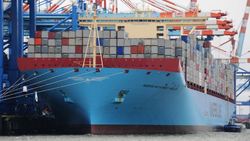Carrier results will give insight into coronavirus impact

With leading container lines Maersk and Hapag-Lloyd providing 2019 result this week, all eyes will be on their outlooks for the year ahead.
Reduced volumes out of China in the first quarter will likely lower earnings estimates for the 2020, but an increase in volume could follow the reopening of China’s factories.
CONTAINER shipping will be looking to Maersk’s and Hapag-Lloyd’s results this week for indications of the impact of coronavirus on the outlook for the year ahead.
While the 2019 full-year results themselves are likely to be positive after a year that was at least benign for box lines, despite the impact of the US-China trade war, the companies’ forecasts for the year ahead will be tempered by the slowdown in container volumes that has occurred since the extension of the Chinese New Year holidays.
The continued closure of factories in many regions in China has left slim volumes around for carriers to compete for, with freight rates now beginning to show the impact of the outbreak, despite carrier efforts to reduce capacity through blankings.
“With many vessels still delayed, and many sailings canceled, the future does not appear that rosy for carriers who are looking at securing stronger ex-Asia rates at this stage,” said analysts at Platts.
Platts added that shippers were “caught between a rock and a hard place” when trying to export from China, with lower rates helping but cargoes often unable to be shipped.
To add to the woes, the World Trade Organisation said today that world merchandise trade growthwas likely to remain weak in early 2020. The Goods Trade Barometer, a measure of trade trends, now reads 95.5, below the 96.6 recorded last November and well below the index’s baseline value of 100.
“This below-trend performance could be reduced further by a new global health threat,” the WTO said.
The current lower figure does not take into account recent developments relating to coronavirus, it added.
“While the year-on-year growth figures for the fourth quarter may pick up slightly, the latest barometer reading provides no indication of a sustained recovery,” the WTO said. “Indeed, year-on-year trade growth may fall again in the first quarter of 2020.”
Against this background, analysts are predicting cautious outlooks from the two box lines reporting this week.
“A hit to volume could push the container market into oversupply, mitigated by blanked sailings and delayed scrubber retrofits,” said Jefferies analysts David Kerstens. “This could support freight rates, which typically fall 30% post-Chinese New Year, but will likely adversely affect costs. We expect stable earnings before interest, taxation, depreciation and amortisation and have cut full-year estimated earnings per share by 20%.”
One bright spot for container lines is that the reduced volumes have been caused by a shortage of supply due to extended factory closures, rather than from a shortage of demand.
“In a perverse way, this could in fact be a perfect storm for many shipowners/operators,” one senior industry figure told Lloyd’s List.
“If they manage to get through the next month or two, by which time, hopefully, the coronavirus will be under control, the demand will surge as importers and retailers in US and Europe will have to replenish their exhausted stocks. And that could bring a boom to demand for containerships and space.”
Hapag-Lloyd will publish its preliminary 2019 results on Wednesday and Maersk’s annual report will be published on Thursday.